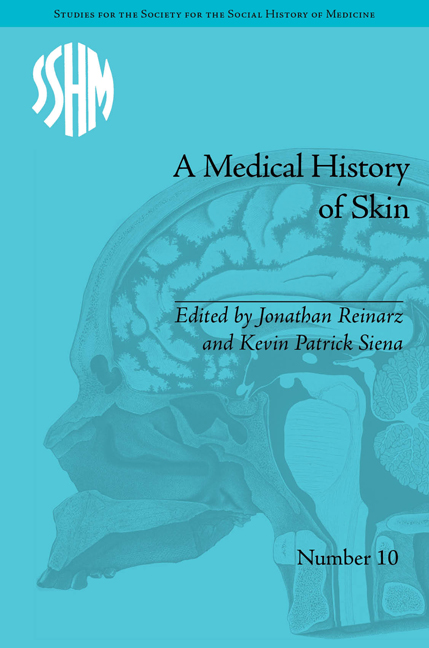Book contents
- Frontmatter
- CONTENTS
- List of Contributors
- List of Figures and Tables
- Scratching the Surface: An Introduction
- Part I The Emerging Skin Field
- Part II Skin, Stigma and Identity
- 5 The Moral Biology of ‘the Itch’ in Eighteenth-Century Britain
- 6 Syphilis, Backwardness and Indigenous Skin Lesions through French Physicians' Eyes in the Colonial Maghreb, 1830–1930
- 7 Discovering the ‘Leper’: Shifting Attitudes towards Leprosy in Twentieth-Century Uganda
- 8 Sex and Skin Cancer: Kaposi's Sarcoma Becomes the ‘Stigmata of AIDS’, 1979–83
- Part III Skin, Disease and Visual Culture
- Afterword: Reading the Skin, Discerning the Landscape: A Geo-historical Perspective of our Human Surface
- Notes
- Index
6 - Syphilis, Backwardness and Indigenous Skin Lesions through French Physicians' Eyes in the Colonial Maghreb, 1830–1930
from Part II - Skin, Stigma and Identity
- Frontmatter
- CONTENTS
- List of Contributors
- List of Figures and Tables
- Scratching the Surface: An Introduction
- Part I The Emerging Skin Field
- Part II Skin, Stigma and Identity
- 5 The Moral Biology of ‘the Itch’ in Eighteenth-Century Britain
- 6 Syphilis, Backwardness and Indigenous Skin Lesions through French Physicians' Eyes in the Colonial Maghreb, 1830–1930
- 7 Discovering the ‘Leper’: Shifting Attitudes towards Leprosy in Twentieth-Century Uganda
- 8 Sex and Skin Cancer: Kaposi's Sarcoma Becomes the ‘Stigmata of AIDS’, 1979–83
- Part III Skin, Disease and Visual Culture
- Afterword: Reading the Skin, Discerning the Landscape: A Geo-historical Perspective of our Human Surface
- Notes
- Index
Summary
In 1858 Jules Arnould, a young military physician aged twenty-eight, was appointed to the hospitals of the Algiers division. Ten years after the end of the war of conquest waged by French troops, he was sent to Dellys, a small coastal town in the region of Kabylia, where he was put in charge of the medical services of the Arab Bureau (Bureau arabe). This local administrative structure, established throughout Algeria since 1844, was placed under the authority of the army and was composed of an Arab secretary, an interpreter, officers and a doctor. At a time when the French military and teachers faced strong resistance, it was frequently up to doctors to establish contact with the indigenous population and to win their confidence by fulfilling the ‘civilizing mission of France’ in the medical field. For many young military doctors Algeria appeared not only as a training ground, but also as an enormous field of observation, suitable to further their doctoral thesis or publications, which were more likely to be noticed insofar as they contributed new knowledge of still poorly understood spaces, populations and diseases.
Taking advantage of his eight months of practice in the Dellys hospital, Arnould decided to render an account of his observations of the indigenous patients who came to see him. In 1862 he published his study, which quickly became a sensation within the metropolitan medical field. His study described in detail ‘one of the most hideous spectacles that dermatological museums could offer’. They were ‘monstrous poxes of which the Middle Ages had left a souvenir – these hideously deformed beings, living ulcers that make even the physician shudder’.
- Type
- Chapter
- Information
- A Medical History of SkinScratching the Surface, pp. 85 - 98Publisher: Pickering & ChattoFirst published in: 2014



